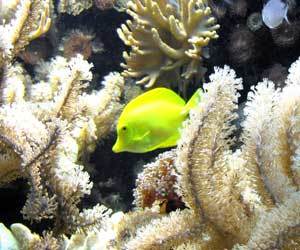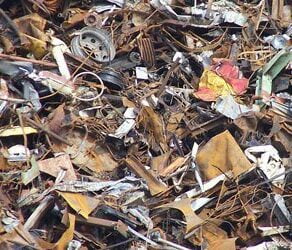
If you’re ready to grab your net to catch your fish and remove him from his tank to clean it, stop right there and leave him be – you need not remove them from the tank to clean it. This is just one of the many things you may not know about cleaning your fish tank properly.
What You Will Need
The first thing you need to do is assemble your supplies. Here’s what you’ll need to get that tank sparkling clean:
- Siphon and gravel vacuum
- Clean bucket or large bowl
- Algae scraper
Preparation
Also, before you get started, you will want to prepare new water to replace the water you’re going to remove from your tank (between 10 and 20 percent of its total volume). If you have saltwater fish, you will need to prepare it to the proper ratio of salt and water. Regardless of the type of marine life you have, you’ll want the water to be the same temperature as the water already in the tank and you will need it to be free of chlorine and other additives. You should either leave the water sitting out on the counter for 48 hours or add dechlorinization solution to avoid undue stress on your fish from any minerals in your tap water.
Use a new bucket or bowl, not one you just used to mop the kitchen floor. You don’t want to risk any trace chemicals from soaps or other cleaning products, which could not only stress out your fish but could kill them. For the same reason, make sure your hands have no residue on them from soap or lotion if you plan on putting them in the tank.
And don’t forget to turn off and unplug the tank’s filter and other electric components before you start the cleaning process.
1. Scrub the sides of the tank
Again, it’s important to note that any cleaning solution you use on the inside or outside of your fish tank could be harmful to your fish and other inhabitants. The fix? Don’t use a cleaning solution! This will save you some time and effort, and most of the soil on the glass inside the tank should come off with an algae scraper, which you can find at a pet supply or aquarium supply store fairly easily. (If this doesn’t work, try a razor blade). To scrub the outside of the tank, including the lid, base and light, you can use a rag or sponge with water only, or you can buy a special fish-safe solution that is made for cleaning aquariums. Again, head to the pet supply store.
2. Siphon out some of the water
The key word here is some. You need to leave enough water in the tank to keep it comfortable for your fish. And this is not only because he’ll need water in order to breathe while you’re cleaning the tank, it’s also because it’s important that you don’t disturb your fish by changing the water conditions in the tank too much at one time. Fish are very sensitive to their environment and it needs to be kept in balance. The highest amount of water to change each time you clean the tank is 20 percent of the volume of the tank. So remove that much or less, never more.
How you use your siphon to remove the water depends on the type of siphon you have. Some require you to use suction from your mouth, others get their suction from the sink tap or through pumping air in and out of the tube. Follow the directions that came with your siphon to achieve the best results. If you’re not sure, call the manufacturer.
Drain the siphoned water into your bucket, bowl or sink.
*Use caution when siphoning the water from the tank. You don’t want to suck up any rocks – or fish for that matter!
3. Sort through the rocks, sand or gravel at the bottom of the tank
The material you have lining the bottom of your tank needs to be cleaned up to remove any food, debris and/or waste. Instead of removing this material from the aquarium and washing it off or replacing it, simply hover over it with the gravel vacuum while it remains in the bottom of the tank, using the siphon to suck up any material that shouldn’t be there.
4. Clean plants, ships, treasure chests, etc.
In most cases, you can clean all of your tank’s accessories using the algae scrubber, but if they are too soiled for this to be the case, take them out of the tank and rinse them in the sink. Do not use soap or any other cleaner on them. Let them air dry before you put them back in the tank.
5. Add the new water
Once you’ve gotten everything in the tank clean, you can add the new water that you have prepared. Simply pour it into the tank or use the siphon to pump it in from the bucket or bowl. Finally, plug the heater, lights, etc. back in. Then watch your fish smile at his brighter, cleaner tank.
Wash the filter
If you have a filter on your tank, you may not want to clean it at the same time as you clean rest of the tank. This could be too much of an environment change for your fish at one time. The best thing to do is to follow the advice in the instruction manual for your specific filter. You can also check out our “how to clean a fish tank filter” guide for more information and tips.
Keeping your fish tank clean
In order to maintain the ability to see your fish through the glass, you should wash your fish tank about once a week. You can also prevent a major algae buildup by getting your fish some algae-eating friends, such as suckermouth catfish. Of course, this will depend on the environment of your aquarium and how many fish you already have living in it. For advice specific to your aquarium, ask an employee at your local pet supply or aquarium store.









An interesting tip I heard from a fellow aquarist was to wash the filter in the water that has been siphoned out. Let the water sit for a bit so that the REALLY dirty and heavy bits settle and then remove the filter and give it a slow muddle and swish in the water. This will not get it spanking clean, but will ensure that you don’t shock the fish or their environment too much.
A properly setup and maintained marine (ie, salt-water) aquarium needs little or no cleaning. Organisms and the natural chemicals in the tank will work in harmony: nitrogenous wastes will be converted to gas and evaporate. E.g.:
My last 70 gal. marine tank never had a change of water in five years, and all chemistry testings, done regularly, remained within normal limits, usually ‘zero’.
The main ‘secret’ is to provide in the tank a ‘zone of anaerobia’, i.e., large areas of very low oxygen concentrations, such as might be provided deep within very porous rock material. It is in that zone that the final conversion of nitrogenous salts are converted into free nitrogen gas (N2), which will then evaporate. Low or no nitrogen = no algae, although some small amounts of ‘hard algae’ are healthy, even desirable; It’s trivial merely to clean the glass and to replenish evaporative loss of tank water.
There are algae scrubbers that have a magnet in them that you can move with a magnet on the outside of the glass so you don’t even have to get your hands into the water to scrape… less stress on the fish, especially the really nervous ones!
That’s all well and good for those that know how to keep a saltwater tank but, for the commoner, we usually opt to have a freshwater tank. Those do need to be cleaned sometimes and there’s a product called the Python that aides in siphoning and filling just with the flick of a switch. Apparently, (I haven’t gotten mine yet) you can hook it up to your faucet and it’ll drain the water from your tank, then you flip a switch and it’ll fill it too. The only thing to keep in mind there is to check the water temp. before you let it run into the tank. I’ve ordered one in the 100 ft length, but they have 50 and 25 too.
Don’t suck on the tube to fill it with water because it is so easy to make a mistake and get a mouthful of aquarium water. Instead, put the entire tube under water and then plug the end of the tube with your thumb while moving that end of the tube into the pail.
In the section named “Keeping your fish tank clean” it suggests to get “some algae-eating friends, such as suckermouth catfish.” FYI: Goldfish are the only ones that can survive with other goldfish. Even the sucker fish & algae eaters will be poisoned to death by the chemicals secreted by the goldfish. I found that out after several of my nieces’ fish had died after they were put with the goldfish. It was a horrible & deadly mistake that will never be made again.
Can goldfish live with koi? My koi has black spots and the number of spots are increasing. The rocks also have white spots. What’s the problem in the tank?
You can put sucker fish in with goldfish, you just have to keep your tank clean. I have two aquariums set up right now both with goldfish and both have plecos in them and they are all very happy. You just have to make sure your tank is clean and all will be good. 🙂
Water turning white an hour or two after a wash is caused by anti-chlorine.
Does a suckermouth catfish eat the dirt and algae in an aquarium?
Akhil,
Suckermouth catfish refers to several species of fish in the Loicariidae family, all of which are known to eat algae to some degree.
Source: Wikipedia – Suckermouth catfish